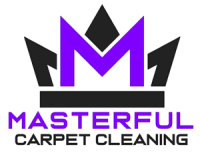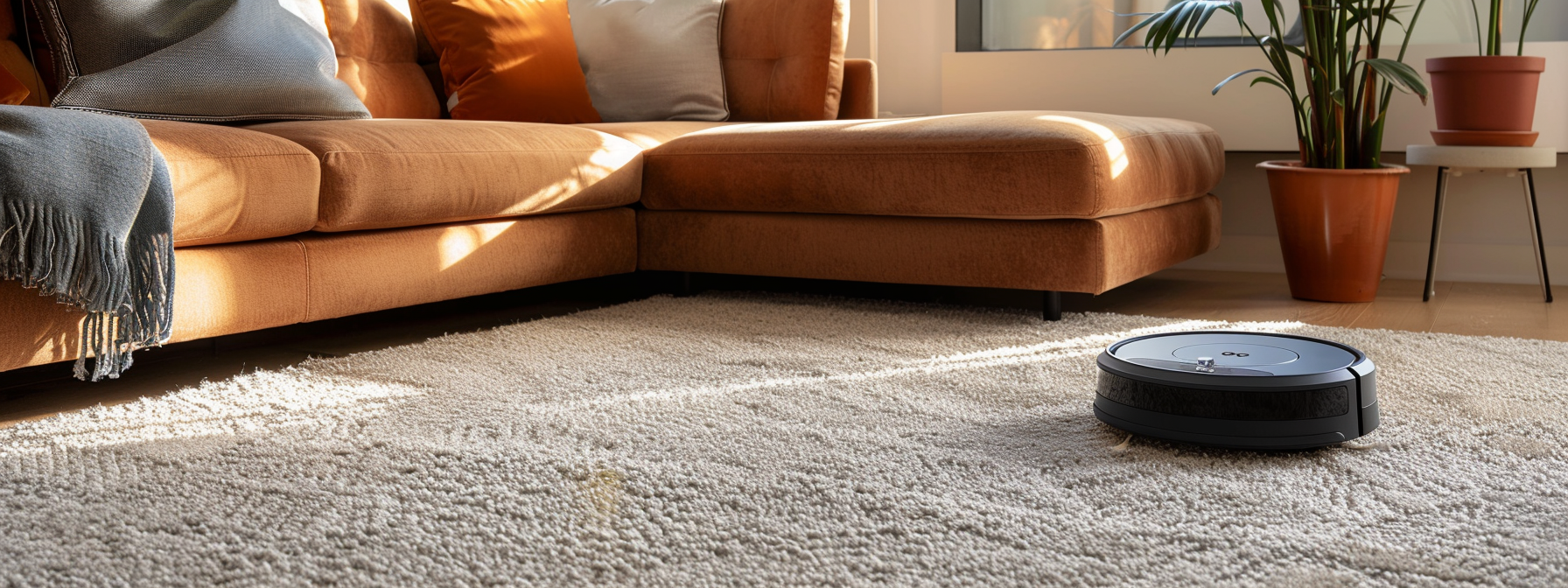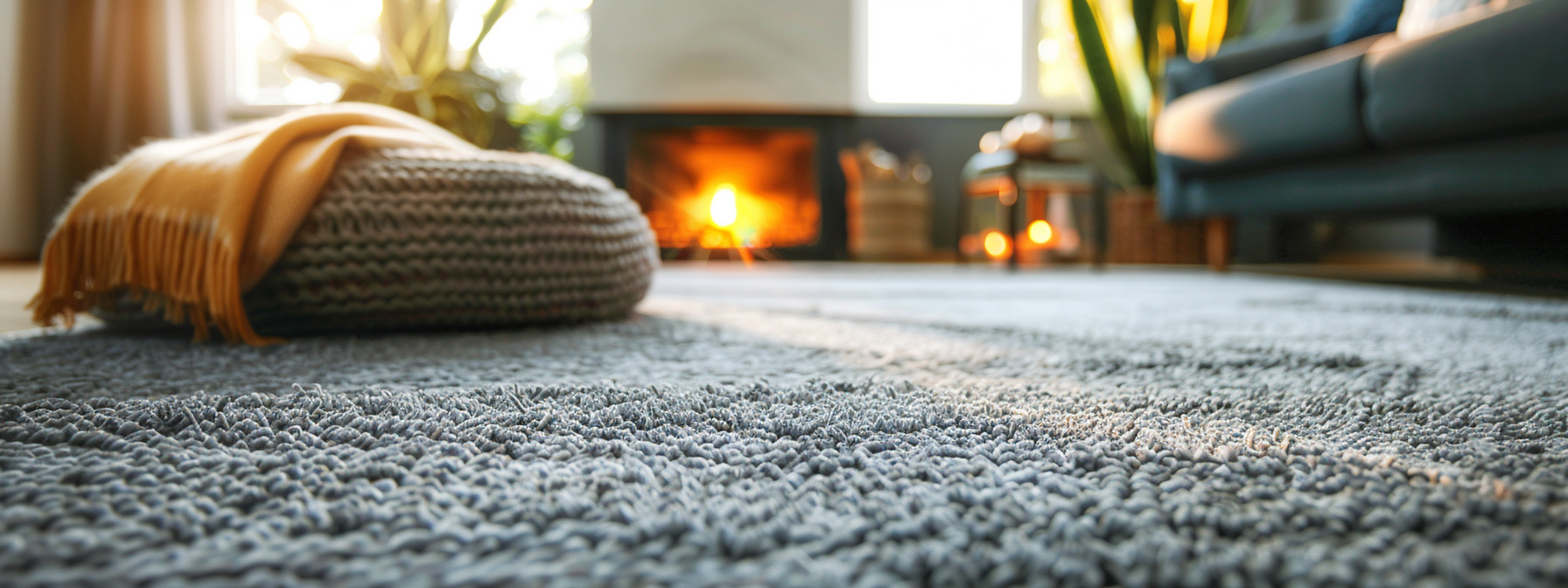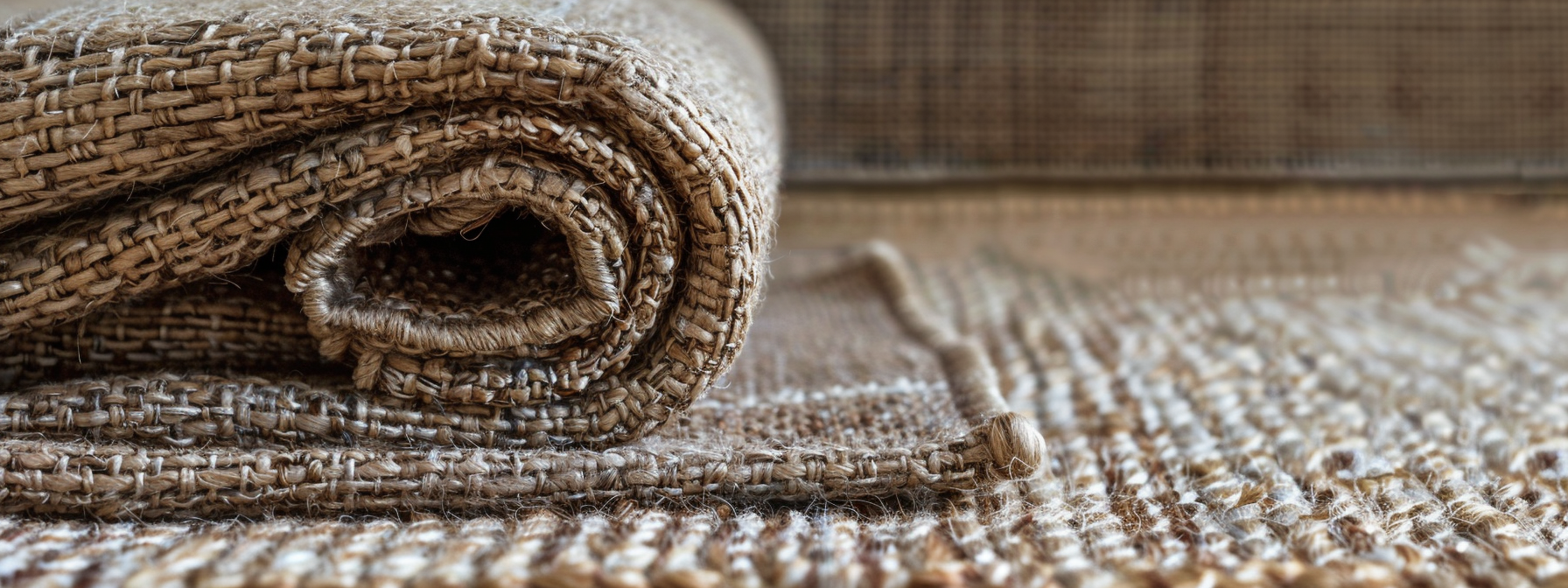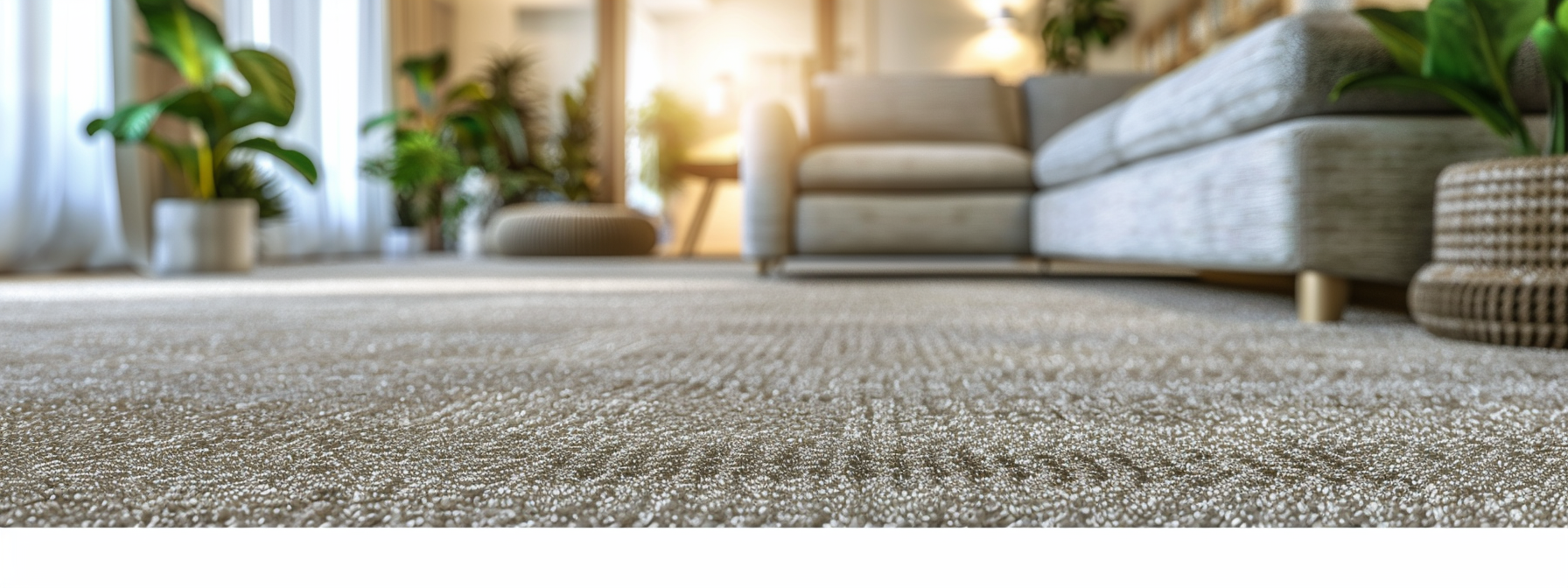Gentle Cleaning Methods for Preserving Your Vinyl Floors
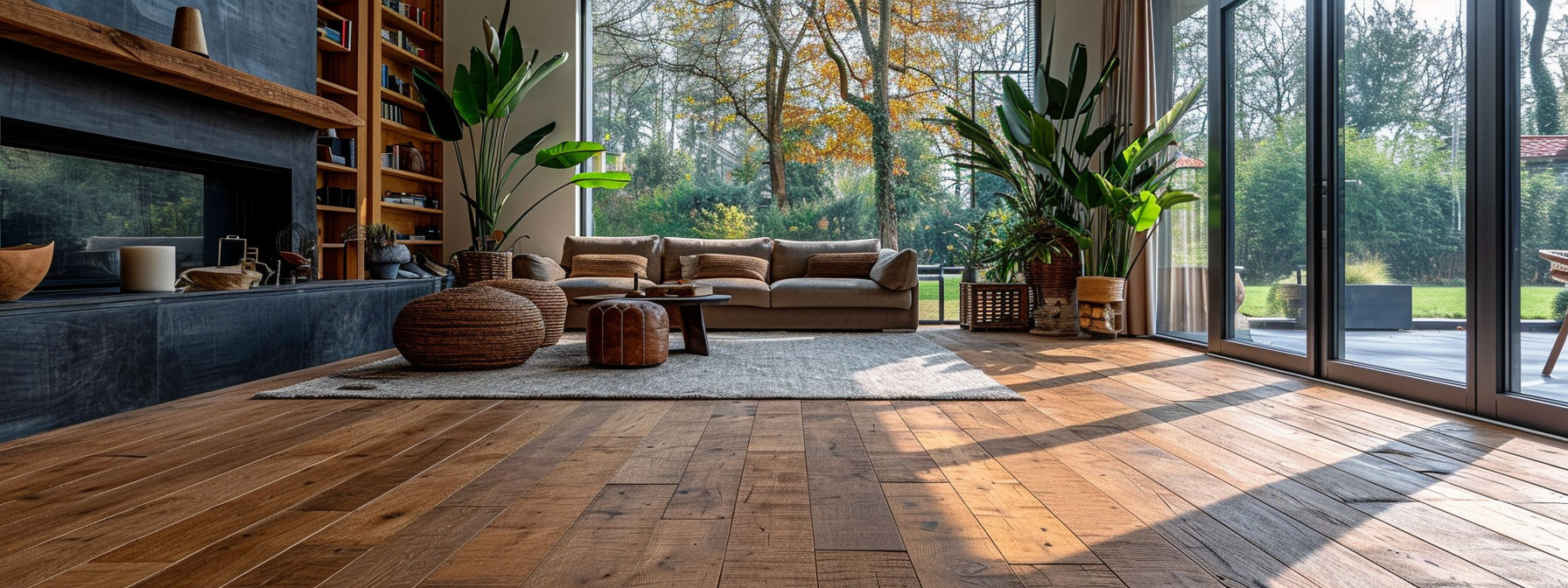
Vinyl flooring, known for its durability and aesthetic appeal, requires specific care to maintain its charm. Proper maintenance not only enhances its appearance but also extends its lifespan.
Preventive Measures: The First Step in Floor Care
Before delving into specific cleaning techniques, it’s important to understand the role of preventive measures in vinyl floor care.
Utilizing walk-off mats, particularly at exterior entrance doors, helps trap dirt and moisture, significantly reducing the need for frequent cleaning. This initial line of defense is crucial in maintaining the floor’s pristine condition.
Understanding the Vinyl Material
The nature of vinyl as a flooring material demands gentle care. Unlike more resilient materials, it is susceptible to damage from abrasive cleaners and rough handling.
Beginning with the Basics: Regular Maintenance
Maintaining vinyl floors starts with daily care. Simple actions like picking up loose debris, including dust, pet hair, and dirt, help prevent surface scratches and dents that can diminish the floor’s appearance over time. Regular maintenance sets the stage for less frequent and less intensive cleaning.
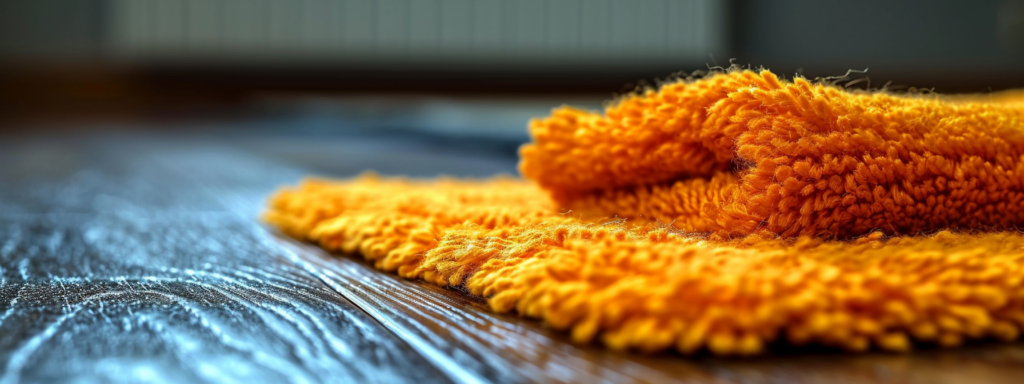
Understanding Vinyl Floors
Vinyl flooring has emerged as a dominant force in the home real estate market, renowned for its versatility and presence in various spaces from basements to dining rooms.
Its widespread popularity, second only to carpeting, is a testament to its adaptability and appeal in diverse home environments.
Composition and Construction
Vinyl flooring is essentially a composite material, primarily consisting of PVC (polyvinyl chloride), plasticizers, and print films.
This combination results in a flooring option that is not only aesthetically versatile but also possesses inherent structural resilience. The top layer, known as the wear-layer, is important for protecting the underlying print film and is typically embellished with a texture to complement the visual design.
Durability and Wear-Layer Significance
One of the key attributes of vinyl flooring is its durability, largely attributed to the wear-layer. This layer is pivotal in determining the floor’s longevity.
Once this layer wears through, the pattern underneath becomes susceptible to damage, necessitating replacement. The thickness of the wear-layer is an important consideration for consumers seeking long-lasting flooring.
Surface Finish for Added Protection
In addition to the wear-layer, vinyl floors are often coated with a surface finish, such as aluminum oxide, providing an extra defense against wear and tear.
This coating, while invisible, adds a layer of protection and anti-slip properties, enhancing the floor’s durability and safety.
Affordability and Practicality
Vinyl flooring stands out for its affordability, offering a cost-effective flooring solution.
This economic advantage, combined with its DIY-friendly nature, makes it an attractive option for homeowners and renovators alike. Its flame-resistant, waterproof qualities and resistance to scratches and scuffs further increase its desirability, especially among families with children and pets.
Aesthetic Appeal and Versatility
Modern advancements in print-film technology and texture embossing have significantly enhanced the aesthetic appeal of vinyl flooring.
Today, it is available in a wide range of colors and patterns, successfully mimicking the look and feel of natural materials like wood. This aesthetic versatility, coupled with its practical benefits, contributes to its popularity in both residential and commercial settings.
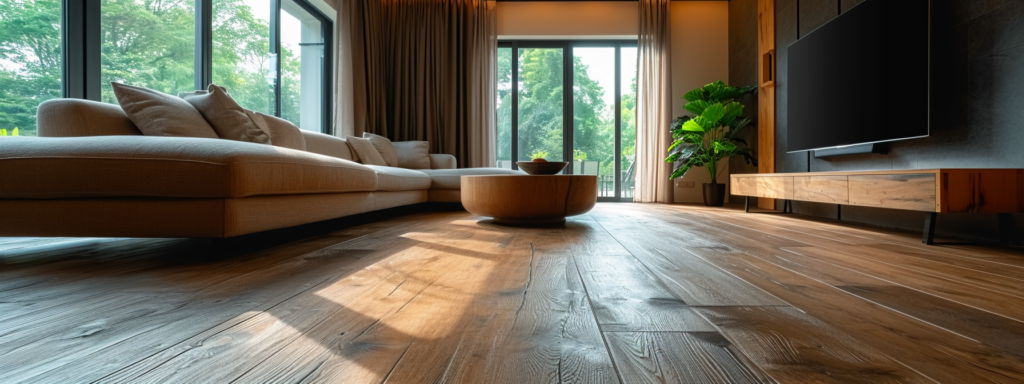
Pre-Cleaning Best Practices for Vinyl Floors
The foundation of keeping vinyl floors in top condition begins with routine maintenance.
Regular actions such as sweeping, vacuuming, or dry mopping are essential to remove surface dirt, dust, and hair.
This not only keeps the floor clean but also prevents the accumulation of debris that can cause scratches or degrade the floor’s finish over time.
Immediate Response to Spills
One of the most crucial aspects of vinyl floor care is addressing spills promptly.
Allowing spills to linger can lead to staining and damage. Wiping them up as soon as they occur with a mop or damp cloth can prevent long-term harm to the flooring.
Use of Doormats and Rugs
Placing quality doormats or area rugs in strategic locations, such as in front of doorways, can significantly reduce the amount of dirt and moisture tracked onto the floor.
This simple step is a proactive measure to minimize the frequency and intensity of cleaning required.
Furniture and Heavy Objects
To avoid scratches and indentations, consider using casters or felt glides under furniture legs. This not only protects the floor but also makes moving furniture easier.
When handling heavy objects like appliances or large furniture, using a plywood panel for movement across the floor can prevent scuffs or damage to the vinyl.
Choosing the Right Cleaning Tools and Solutions
It’s important to select the appropriate tools and cleaning solutions for vinyl floors. Avoid using abrasive scrubbers, steel wool, or beater bar attachments on vacuums, as these can damage the surface.
For cleaning solutions, opt for mild detergents or specific cleaners designed for vinyl floors. Harsh chemicals like ammonia should be avoided as they can degrade the material.
Preventive Measures for Discoloration
To prevent potential discoloration, it’s recommended to use mats or rugs with breathable backing.
Avoiding mats with rubber or latex backing is also essential, as these materials can cause permanent stains on the vinyl flooring.
Cautions Against Certain Products
Certain products and practices should be avoided to maintain the integrity of vinyl floors.
These include detergents, abrasive cleaners, mop and shine products, paste wax, solvent-based polishes, and ammonia-based cleaning solutions. Such products can leave a dull film on the floor, break down the material, or cause cracks.
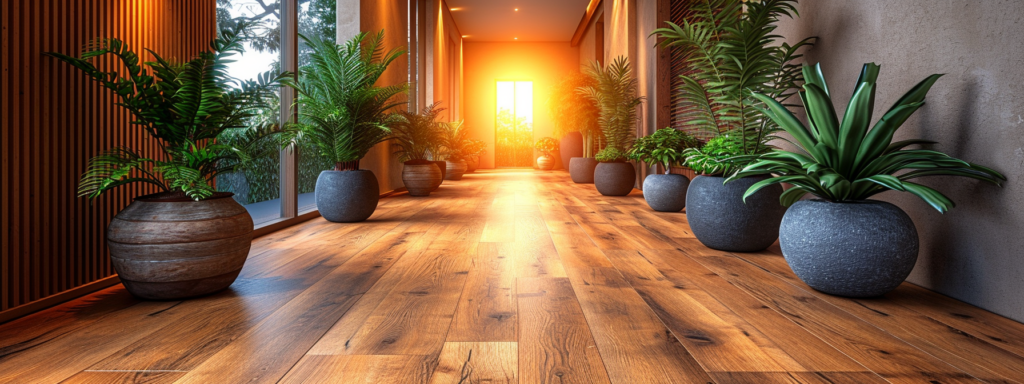
Gentle Cleaning Solutions for Vinyl Floors
The Basics: Water and a Sponge Mop
For day-to-day cleaning, the simplest and most gentle solution for vinyl floors is plain water used with a sponge mop.
This basic approach is effective for regular maintenance and ensures that the floor is not exposed to harsh chemicals or abrasive substances. It’s important to mop frequently with plain water, especially after wiping up spills, which should be addressed immediately to prevent staining.
Vacuuming and Dry Mopping
Before wet cleaning, it’s advisable to vacuum or dry mop the floor to remove surface dirt, dust, and hair. This step is important for preventing scratching and ensuring a thorough cleaning.
Pay attention to getting under furniture, in corners, and along baseboards to remove all traces of dirt and debris.
Apple Cider Vinegar: A Natural Cleaner
A highly recommended natural cleaner for vinyl flooring is apple cider vinegar. The acidity in vinegar effectively removes dirt and grime without leaving behind any soap or wax build-up.
To create a cleaning solution, mix one cup of cider vinegar with a gallon of hot water. For disinfecting, substitute white vinegar for cider vinegar.
If the floor is particularly dirty, adding a few drops of liquid dishwashing soap to the mixture can enhance the cleaning power. To add shine, consider adding a few drops of baby oil to the vinegar and water solution.
Addressing Stubborn Stains and Scuffs
For tougher stains like grape juice, mustard, or tomato sauce, a paste made from baking soda and water can be gently rubbed onto the stain until it disappears, followed by a thorough cleaning to remove any baking soda residue.
For scuffs, applying WD-40 lubricant or jojoba oil on a towel and rubbing the area can be effective. After treating these areas, clean thoroughly with the vinegar and water solution to remove any lubrication traces.
A soft, nylon-bristle brush can also be useful for removing various stains, especially when used with common household solvents like rubbing alcohol or mineral spirits.
Commercial Cleaners for Vinyl Floors
For those who prefer commercial cleaning products, there are several options specifically designed for vinyl floors.
These include Pine-Sol Multi-Surface Cleaner, Armstrong’s Once ‘n Done No-Rinse Floor Cleaner, and Pledge Multisurface Floor Cleaner. When selecting commercial cleaners, it is important to choose products that are suitable for vinyl flooring to ensure gentle yet effective cleaning without damaging the surface.

Methodical Cleaning Techniques for Vinyl Floors
Before embarking on the cleaning process, it’s important to prepare the area. Start by removing any obstacles or furniture that might impede the cleaning process.
This not only facilitates ease of movement but also protects your furniture and mop from damage. After clearing the area, proceed to sweep or vacuum the floor to eliminate loose dirt and debris. Pay special attention to corners and nooks, as these areas tend to accumulate dirt and can make the mopping process less effective.
Choosing the Right Mop and Cleaning Solution
The selection of an appropriate mop is critical for effective cleaning without damaging the vinyl flooring.
Various mop types are available, including steam mops, which use hot steam to loosen dirt. Caution is advised with steam mops on vinyl floors due to their sensitivity to heat and moisture.
When it comes to cleaning solutions, a combination of white vinegar, dish soap, and warm water is recommended. White vinegar acts as a natural disinfectant and deodorizer, while dish soap serves as an effective grease-cutting agent. Warm water aids in dissolving the solution, making it more effective.
Mopping Process
Begin the mopping process with a solution of warm water and a mild detergent. Ensure the mop is damp but not overly wet, as excess water can damage the vinyl flooring.
When mopping, it’s important to be gentle to avoid scratching or scuffing the surface. Mop the floor in sections, carefully working your way across the room, and take care not to mop yourself into a corner.
Dealing with Stubborn Stains
If you encounter stubborn stains, apply a bit of the cleaning solution directly to the stain and allow it to sit for a few minutes before gently scrubbing with a soft cloth or sponge.
Avoid using abrasive scrubbers that could scratch the vinyl. After addressing stains, rinse the floor with clean water to remove any soap residue, and ensure to wring out the mop or cloth thoroughly to prevent excessive moisture.
Final Drying and Prevention
After mopping, use a clean, dry cloth or mop head to wipe down the floor and remove any remaining moisture. This step is important as standing water can cause damage over time.
To maintain the vinyl’s longevity, use doormats at entryways to trap dirt and prevent tracking onto the floor, and place rugs or runners in high-traffic areas to protect the vinyl from wear and tear. Regular cleaning and rotation of rugs are also advised to prevent dirt buildup.
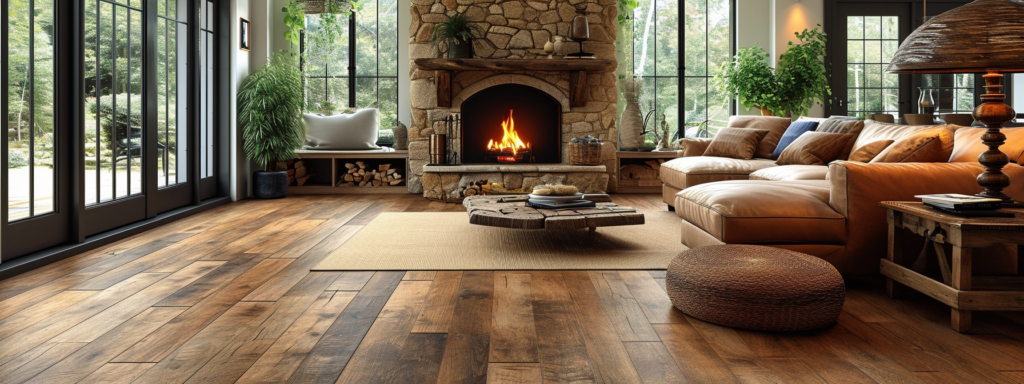
Dealing with Stains and Spills on Vinyl Floors
When dealing with stains on vinyl floors, the first step is typically using a mild cleaning solution. Liquid dishwashing soap mixed with warm water is a great starting point.
Apply this solution using a soft towel or sponge, then rinse with water. Repeat the process if necessary, but remember never to use a sponge with a scouring side, as it can scratch the vinyl floor.
Lemon for Discoloration and Grass Stains
Lemon juice, due to its citric acid content, is effective in removing discoloration and grass stains.
Simply slice a lemon in half and apply it directly to the stained area. Let the lemon juice sit for a few minutes, then rinse with warm water. This method not only removes stains but also leaves a fresh citrus smell.
Baking Soda for Acidic Stains
Baking soda is particularly effective for acidic stains like wine, fruit juice, or tomato sauce.
Mix baking soda with water to create a paste, apply it to the stain using a soft cloth, and gently rub in a circular motion. Rinse and repeat as necessary. Baking soda is a versatile, budget-friendly product found in most kitchens, making it a convenient option for stain removal.
Rubbing Alcohol for Tough Stains
Rubbing alcohol is a mild solvent that works well on tough stains such as heel marks, make-up, or ink.
Apply it using a soft brush or cloth, gently rub the stain, and then rinse the area with water. It’s important to be patient with stubborn stains, as they might take some time to be fully removed.
Oxalic Acid for Rust Stains
For rust stains, oxalic acid is a recommended solution. Often labeled as “wood bleach,” oxalic acid can be found in most paint stores.
Apply the acid solution to the stain and let it sit for about 10 minutes, repeating if necessary. After treatment, rinse the floor with clean water.
Using Bleach Carefully
Bleach can be effective for particularly stubborn stains like ink. Dilute one part bleach with four parts water, soak a rag in it, and place it over the stain for up to an hour.
Always use bleach with caution, wearing protective gloves and ensuring proper ventilation. It’s important to monitor the progress when using bleach to avoid damaging the surrounding areas of the floor.
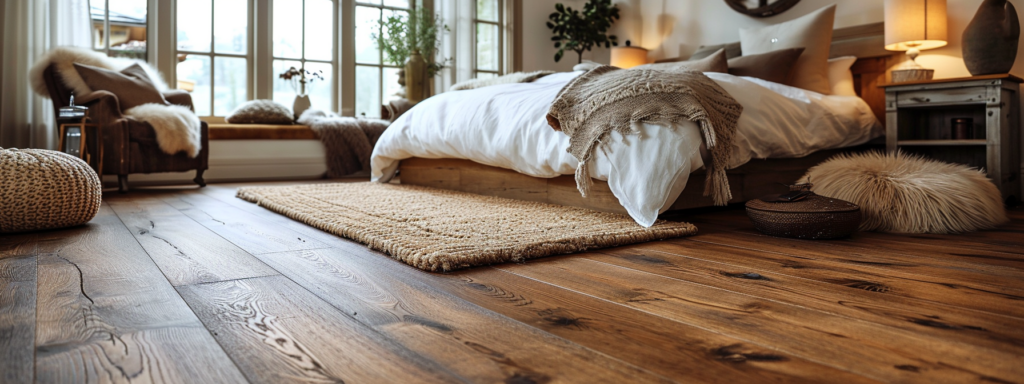
Long-term Maintenance and Care for Vinyl Floors
For maintaining the aesthetic and durability of vinyl floors over the long term, regular cleaning is essential. Sweeping is strongly advised to remove dust, sand, and grit particles, especially in areas with high foot traffic.
The frequency of sweeping depends on the room’s usage and wear and tear. In addition to sweeping, wet mopping with an approved cleaning solution can be employed, but care must be taken not to allow water to pool on the vinyl. Despite vinyl’s waterproof properties, excessive water can be detrimental.
Also, any spills should be wiped up immediately to prevent stains and lingering messes. Immediate action is key to preventing long-term damage to vinyl floors.
Furniture Handling and Floor Protectors
To prevent scratches and dents, avoid dragging furniture across vinyl floors. Always lift and carry furniture when moving it.
For heavy furniture or appliances that remain stationary for extended periods, use flat, non-staining floor protectors. These protectors are essential for preventing dents in the vinyl flooring underneath the furniture.
Appropriate Vacuuming Techniques
When vacuuming vinyl floors, avoid using a vacuum with a “beater bar” attachment. While beater bars are effective for carpets, they can damage vinyl floors.
Most modern vacuums come with a “bare floor” setting, which is more suitable for vinyl floors and helps avoid damage while ensuring cleanliness.
Utilization of Floor Mats
Investing in high-quality floor mats and placing them at entrances and exits can provide an extra layer of protection for vinyl floors.
These mats are effective in collecting and trapping corrosive substances like dirt, sand, oil, grit, and asphalt that can be tracked in from outside. Regular cleaning and rotation of these mats are also recommended to prevent dirt buildup and ensure their effectiveness in protecting the floors.
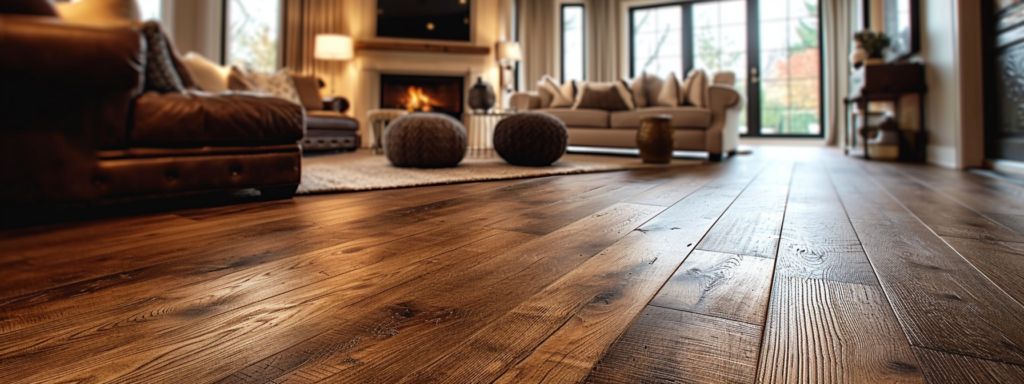
Common Mistakes to Avoid in Vinyl Floor Maintenance
Neglecting Regular Sweeping and Dusting
A frequent error in vinyl floor maintenance is the lack of regular sweeping and dusting. Over time, accumulated dirt, dust, and debris can scratch the surface and dull the floor’s shine.
Daily sweeping with a soft-bristle broom or vacuuming with a soft brush attachment is recommended. It’s important to avoid vacuums with rotating brushes, as they can scratch the vinyl. Regular cleaning of the vacuum or broom itself is also essential to prevent spreading dirt and allergens.
Using Harsh Chemical Cleaners
Harsh chemicals like bleach and ammonia are abrasive and can damage the vinyl floor’s surface, causing discoloration and deterioration.
It’s advisable to use milder, pH-neutral cleaners designed specifically for vinyl floors. When choosing a cleaning product, read the label carefully to ensure it’s safe for vinyl floors, and dilute it according to the instructions. Always test the cleaner in a small, inconspicuous area before applying it to the entire floor.
Excessive Water and Moisture
A common misconception is that more water equates to better cleaning for vinyl floors. Vinyl floors are water-resistant, not waterproof.
Excessive water and moisture can weaken the adhesive, causing the floor to warp or bubble. Use a damp mop or microfiber cloth for cleaning, ensuring it is only slightly damp. Avoid steam mops or high water pressure, as they can penetrate the seams and cause damage.
Delaying Stain Removal
Not addressing spills and stains promptly can lead to stubborn stains that are difficult to remove. To avoid permanent damage, clean up spills and stains immediately.
Gently blot the spill with a clean cloth or paper towel, then clean the area with a mild vinyl floor cleaner. For stubborn stains, a soft bristle brush can be used with gentle pressure to avoid scratching the vinyl.
Waxing
Many believe that waxing is required to maintain the shine of vinyl floors. Wax can create a dull, sticky residue that attracts dirt and grime.
Instead, use a floor polish formulated specifically for vinyl floors. These polishes provide a protective layer that enhances the shine and makes cleaning easier. Apply the product according to the manufacturer’s instructions and periodically remove the old polish before reapplying.
Hard Scrubbing
Vigorous scrubbing of vinyl floors can cause visible scratches and damage the surface. Adopt a gentle approach when cleaning, and avoid abrasive scrub brushes or scouring pads.
Use a soft-bristle brush or microfiber cloth with gentle pressure for tough stains. If the stain persists, consider a mild vinyl floor cleaner or a mixture of warm water and vinegar. Patience and a gentle touch are crucial for preserving vinyl floors.
Using Abrasive Detergents and Cleaning Tools
Avoid using abrasive detergents, acidic cleaners, bleach, and bleach-based cleaners, which can harm vinyl floors. Also, refrain from using abrasive cleaning tools like scrubbers and steel wool.
These can cause micro-tears in the vinyl and reduce its life expectancy. For furniture, avoid castor wheels, which collect particles and create abrasions on the floor, opting for felt sliders instead.
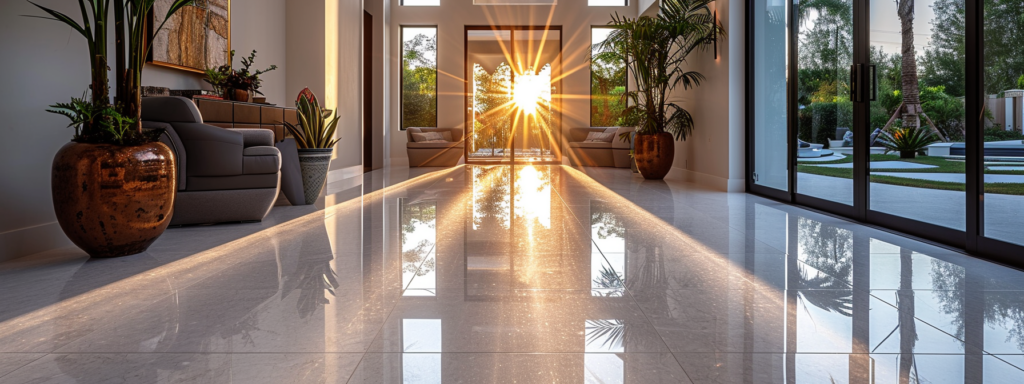
Frequently Asked Questions: Vinyl Floor Cleaning
What is the best way to clean vinyl floors?
The most effective way to clean vinyl flooring is to use plain water with a sponge mop for regular maintenance.
For intensive cleaning, vacuum or dry mop first to remove surface dirt, then use a mixture of apple cider vinegar and water. Adding a few drops of liquid dish soap can help with particularly dirty floors. For stains, use a baking soda paste or rubbing alcohol, depending on the type of stain.
Are there any products I should avoid using on vinyl flooring?
Yes, avoid using a vacuum with a “beater bar” attachment, highly abrasive scrubbers, steel wool, detergents, abrasive cleaners, “mop and shine” products, paste wax, solvent-based polishes, and ammonia or ammonia-based cleaning solutions.
These can damage the flooring surface, leave a dull film, or cause the material to crack.
How can I prevent damage to my vinyl flooring?
To prevent damage, minimize dirt, stains, and abrasions before they occur. Use good-quality doormats or area rugs at entrances to trap grit and grime.
When moving furniture, use a sheet of plywood or paneling to prevent scuff marks or tears, and consider using vinyl coasters under furniture feet to avoid indentations.
Author
-

As the Co-Owner of Masterful, Randy has been providing quality cleaning services to the Salem and Portland areas of Oregon for many years. He has built a reputation for excellence in the industry. His team take prides in using the latest cleaning techniques and technologies to deliver exceptional results every time.
